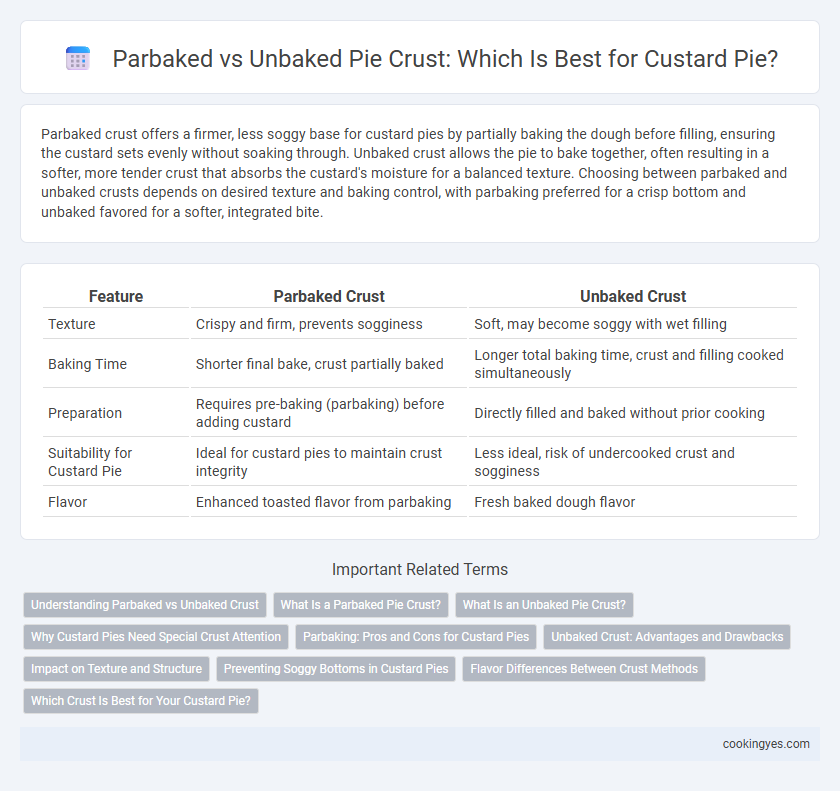Parbaked crust offers a firmer, less soggy base for custard pies by partially baking the dough before filling, ensuring the custard sets evenly without soaking through. Unbaked crust allows the pie to bake together, often resulting in a softer, more tender crust that absorbs the custard's moisture for a balanced texture. Choosing between parbaked and unbaked crusts depends on desired texture and baking control, with parbaking preferred for a crisp bottom and unbaked favored for a softer, integrated bite.
Table of Comparison
| Feature | Parbaked Crust | Unbaked Crust |
|---|---|---|
| Texture | Crispy and firm, prevents sogginess | Soft, may become soggy with wet filling |
| Baking Time | Shorter final bake, crust partially baked | Longer total baking time, crust and filling cooked simultaneously |
| Preparation | Requires pre-baking (parbaking) before adding custard | Directly filled and baked without prior cooking |
| Suitability for Custard Pie | Ideal for custard pies to maintain crust integrity | Less ideal, risk of undercooked crust and sogginess |
| Flavor | Enhanced toasted flavor from parbaking | Fresh baked dough flavor |
Understanding Parbaked vs Unbaked Crust
Parbaked crusts for custard pies offer a partially cooked base that reduces sogginess by creating a barrier between the filling and the crust, ensuring a crisp texture. Unbaked crusts absorb moisture from the custard filling during baking, often resulting in a softer, sometimes soggy bottom layer. Choosing between parbaked and unbaked crusts depends on desired texture and baking time, with parbaking providing better crust integrity for custard pies.
What Is a Parbaked Pie Crust?
A parbaked pie crust is partially baked before adding the custard filling, ensuring it remains crisp and prevents sogginess caused by the liquid custard. This technique is crucial for custard pies, as it allows the crust to set without fully cooking, creating a firm barrier. Unbaked crusts often absorb moisture from the custard, resulting in a soggy base that compromises texture and flavor.
What Is an Unbaked Pie Crust?
An unbaked pie crust, also known as a raw or uncooked crust, is a pastry shell that has not undergone any baking before being filled. This type of crust is often used for custard pies to allow the filling to cook and set directly in the dough, ensuring a tender and flaky texture. Parbaked crusts, by contrast, are partially baked before adding the filling, which can create a firmer base but may alter the custard's creamy consistency.
Why Custard Pies Need Special Crust Attention
Custard pies require a parbaked crust to prevent sogginess and ensure it holds the delicate filling without becoming waterlogged. Unbaked crusts often fail to create a barrier against the high-moisture custard, resulting in a soggy, uneven texture. Parbaking firms the crust, maintaining its structural integrity and delivering the crispness essential for a perfect custard pie.
Parbaking: Pros and Cons for Custard Pies
Parbaked crusts offer a firmer, less soggy base for custard pies by partially cooking the dough before filling, ensuring a crisp texture that holds up to the wet custard. However, parbaking requires careful timing to avoid over-browning or undercooking, which can negatively affect the crust's taste and structural integrity. Unbaked crusts, while simpler to prepare, often risk becoming soggy as the custard bakes and moisture seeps in.
Unbaked Crust: Advantages and Drawbacks
An unbaked crust for custard pie offers the advantage of retaining a tender, flaky texture by avoiding overbaking and allows the crust to absorb some custard moisture, enhancing flavor integration. However, this method carries the risk of a soggy bottom if the custard filling releases excessive liquid during baking, potentially compromising the crust's structural integrity. Achieving a perfect balance often requires using a high-fat pastry dough and careful baking time management to ensure the custard sets without oversaturating the crust.
Impact on Texture and Structure
Parbaked crust for custard pie ensures a firmer, more stable base by partially cooking the dough, which prevents sogginess and maintains textural integrity when filled with wet custard. In contrast, unbaked crust often absorbs moisture from the custard, resulting in a softer, sometimes overly fragile crust that can compromise the pie's structure. Choosing a parbaked crust optimizes the balance between flakiness and support, delivering a custard pie with a consistent bite and improved overall texture.
Preventing Soggy Bottoms in Custard Pies
Parbaked crusts create a barrier that prevents custard from soaking into the dough, effectively eliminating soggy bottoms by setting the crust's structure before filling. Unbaked crusts absorb custard moisture during baking, often resulting in a wet, limp base that compromises texture. For custard pies, parbaking ensures a crisp, firm bottom that holds the filling without becoming mushy.
Flavor Differences Between Crust Methods
Parbaked crusts for custard pies create a slightly toasted, nutty flavor that enhances the overall taste profile by preventing a soggy bottom. Unbaked crusts offer a more tender and buttery texture with a fresher dough flavor but risk becoming undercooked if not baked properly with the filling. Choosing parbaked crusts intensifies caramelized notes, while unbaked crusts maintain a delicate, raw pastry essence in the final custard pie.
Which Crust Is Best for Your Custard Pie?
Parbaked crust is often best for custard pies because it prevents the crust from becoming soggy by providing a firmer base that holds up to the liquid filling. Unbaked crusts may absorb moisture during baking, leading to a less crisp texture and potential filling leakage. Choosing a parbaked crust ensures a perfectly golden, crisp shell that enhances the creamy custard while maintaining structural integrity.
Parbaked Crust vs Unbaked Crust for Custard Pie Infographic

 cookingyes.com
cookingyes.com